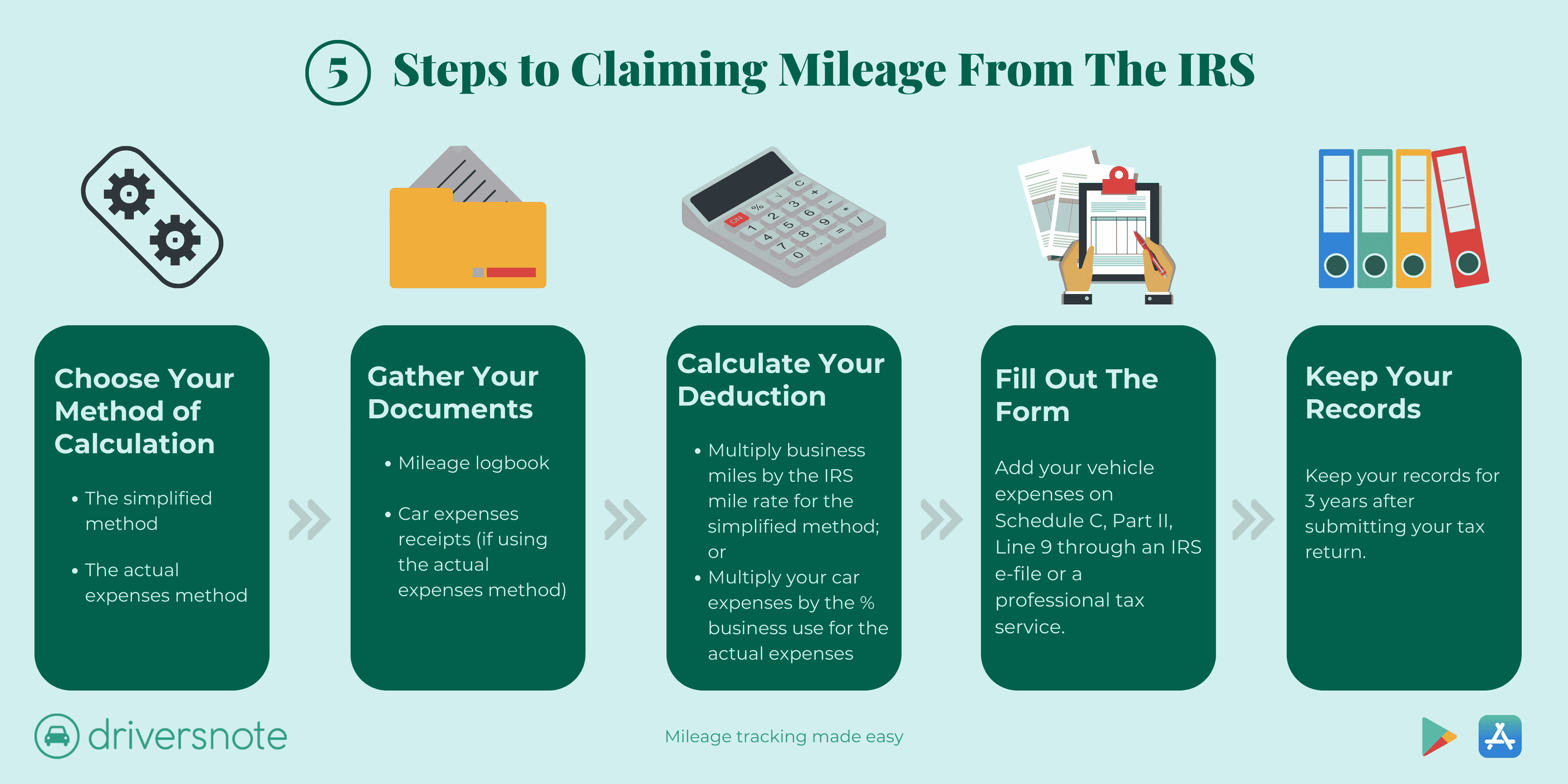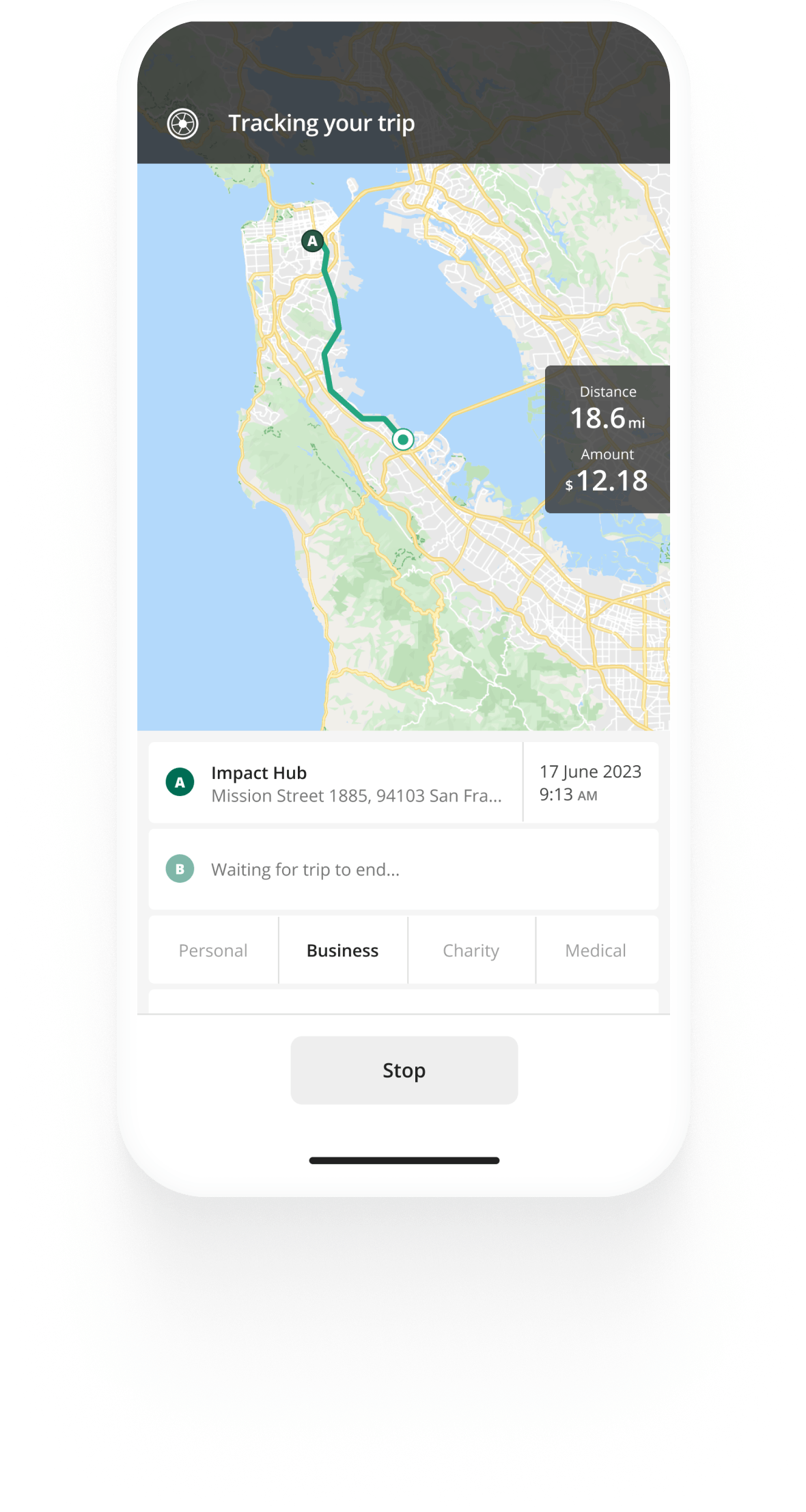Track mileage automatically
Get startedHow to Claim Mileage on Taxes in Five Steps
Claiming a mileage deduction is an important part of reducing taxes for anyone who uses their vehicle for business. Are you wondering how claiming mileage works and if you're eligible? Follow the five simple steps below to claim mileage on your taxes.
Who can claim mileage on taxes
Those eligible to claim mileage on their taxes are:
- Self-employed individuals, contractors, and business owners
- Armed Forces reservists
- Qualified performing artists
- Fee-basis state or local government officials
- Employees with impairment-related work expenses

You are welcome to use the infographic above on your website. Just remember to credit Driversnote with a link to this article.


Mileage tracking made easy
Trusted by millions of drivers
Automate your logbook Automate your logbook

Automatic mileage tracking and IRS-compliant reporting.
Get started for free Get started for freeStep 1: Choose your method of calculation
You can claim mileage either by the standard mileage rate method or the actual expenses method.
Standard mileage rate method
The standard mileage rate method allows you to keep track of your business miles and use the standard mileage rate given by the IRS to calculate your mileage claim.
The 2025 IRS mileage rate is 70 cents per business mile. If you're claiming mileage for 2024, use the 67 cents per mile rate applicable to that year.
Actual expenses method
The actual expenses method lets you claim the expenses you’ve had throughout the year related to your business miles. If you use this method, you will need to track all your car-related expenses, as well as your mileage.
Find out more about the two methods for claiming mileage on your taxes in our guide to self-employed mileage deduction rules.
Limitations to the methods
There are a few limitations you should be aware of when picking a method to use for your mileage claim:
- If you used your car for business-related driving in the first year and claimed mileage using the actual expenses method, you can only use this method for that same vehicle in the following years.
- If you used your car for business driving in the first year and claimed mileage using the standard mileage rate method, you can use either method to claim your business miles at tax time in the following years.
- If you lease a car, you lock yourself into the first method you use for the duration of the lease, including renewals. This goes for both the standard mileage rate and the actual expenses method.
If you’re eligible to use both methods and have kept records of both your mileage and car expenses, calculate your mileage claim using both methods and select whichever gives you the highest deduction.
Step 2: Gather your mileage records
The necessary documents will depend on which method you use. If you use the standard mileage deduction method, you’ll need your mileage logbook.
If you are claiming your actual expenses, you’ll need both your mileage logbook and all receipts for your car expenses throughout the year.
Step 3: Calculate your mileage claim
Standard mileage rate method
Now it's time to work out how much mileage to claim on taxes.
If you’re using the standard mileage deduction, multiply the total business miles you recorded for the year by the standard mileage rate for the applicable year.
Try the mileage calculator below to see how much you can deduct for current and recent tax years.
Actual expenses method
If you use the actual expenses method, add up all of your vehicle-related expenses for the year and multiply this figure by the percentage of your car used for business.
Step 4: Fill out the correct tax form
For self-employed and business owners
If you are self-employed, a contractor, or a business owner, use Schedule C, Part ll, Line 9. You will also need to complete Part lV, in which you will give the following information on your vehicle:
- The year you placed your vehicle into business use
- The total number of miles you drove your vehicle and the miles you drove for business, commuting, and other purposes
- If your vehicle was available for use during off-duty hours
- If you or your spouse have another vehicle available for personal use
- Evidence to support your deduction—this would be a mileage logbook and receipts for your car expenses if you are using the actual expenses method.
You can fill out Schedule C in paper form or online by using IRS e-file or a professional tax service.
For qualified employees
If you are an Armed Forces reservist, qualified performing artist, fee-basis state or local government official, or an employee with impairment-related work expenses, use Form 2106 to claim mileage on taxes.
Step 5: Retain your records
You should keep your mileage claim records for at least three years from the date you file your tax claim or at least two years from the date you paid the tax, whichever is later. This is the period within which the IRS can initiate an audit.
Most employees cannot claim mileage on taxes
According to the Tax Cuts and Jobs Act, most employees cannot claim mileage until January 2026, even if they’re not reimbursed by their employer for business mileage expenses.
FAQ

Tired of logging mileage by hand?
Effortless. IRS-compliant. Liberating.
IRS Mileage Guide
- For Self-Employed
- For Employees
- For Employers
- Mileage Log Requirements
- How To Claim Your Mileage On Taxes In 5 steps
- Calculate Your Reimbursement
- Is Reimbursement Taxed?
- Current Mileage Rates
- Historical IRS Mileage Rates
- IRS Medical and Charitable Mileage
- California Mileage Reimbursement
- How is the IRS Mileage Rate Calculated